Winners and losers in the population game
Transmitter technical assistance provided to global partners
March 31, 2014Camellia in Glenmore Neighborhood, Chesapeake 4/3/2014
April 3, 2014Through time, the fortunes of species rise and fall reflecting the underlying conditions and demographic fundamentals. Tracking populations through time allows the conservation community to see which species are in trouble and which species are in need of research to determine root causes. Understanding causal factors is a first step toward either developing remedies or acknowledging that the declines are beyond management influence. The Center for Conservation Biology (CCB) has recently compiled the results of the 2013 colonial waterbird survey for Virginia. The broad community-wide findings identify some clear-cut winners and losers over the past twenty years.
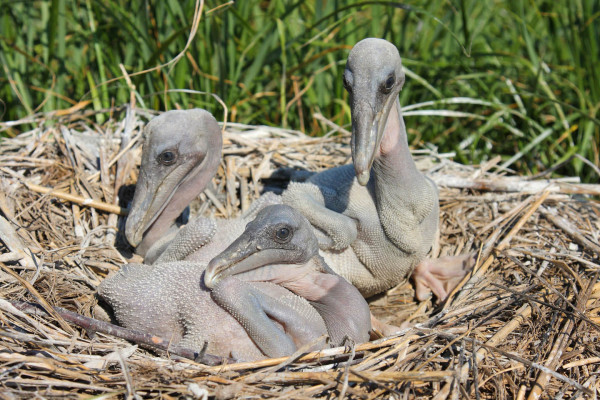
Brood of brown pelicans on Smith Island in the Chesapeake Bay. Pelicans have been one of the big winners increasing 7 fold over the past 20 years. Photo By Bart Paxton.
Within the winners’ camp are primarily species that have colonized the state in the past forty years, including double-crested cormorant, brown pelican, white ibis, and great black-backed gull. Double-crested cormorants have increased from 6 pairs in 1978 to 2,876 pairs in 2013 and have increased eight-fold over the past twenty years alone. Similarly, brown pelicans have increased from 30 pairs in 1987 to 2,454 pairs in 2013 and have increased nearly seven-fold over the past twenty years. Great black-backed gulls have increased from a first breeding attempt in 1970 to 1,172 pairs in 2013 and have more than doubled over the past twenty years. The white ibis, a recent colonizer of Virginia, has increased from just 3 pairs in 1993 to 369 pairs in 2013.
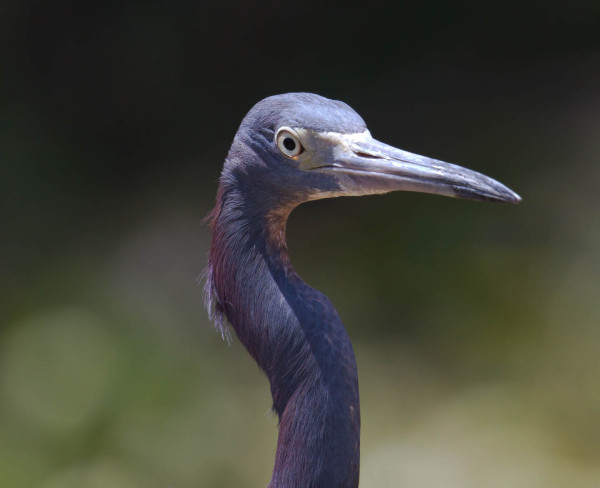
Little blue herons have been one of the big losers within Virginia since the mid-1970s and have experienced a 57% decline over the past 20 years. Photo by Bryan Watts.
The losers’ camp includes several species that should be considered for life support and several others that continue to experience a slow-burn decline. Species that should receive immediate life support include cattle egret, little blue heron, glossy ibis, and gull-billed tern. The cattle egret stands out as having experienced a greater than 96% decline in only twenty years (1,459 to 56 pairs). Both little blue herons and glossy ibis have declined from thousands in the 1970s to just 178 and 484 pairs, respectively, including a 57% decline since 1993. The gull-billed tern continues a long decline reaching a low of only 294 pairs in 2013. Many other species have experienced much shallower declines, including snowy egret, tricolored heron, black-crowned night heron, herring gull, least tern, and black skimmer.
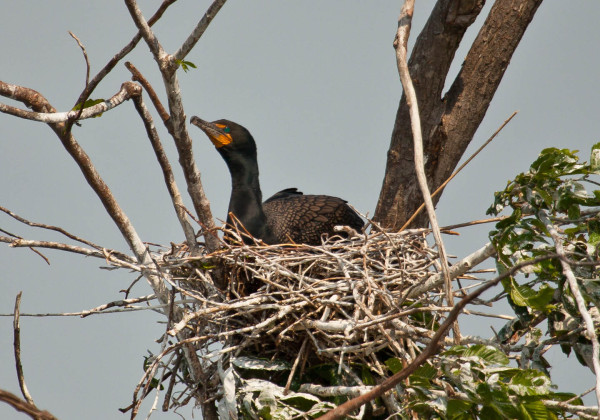
Double-crested cormorant incubating within a colony on the James River near Hopewell. This species has exploded since becoming well established in the lower Chesapeake Bay. Over the past 20 years they have been one of the big winners with a population increase of 8 fold. Photo by Bryan Watts.
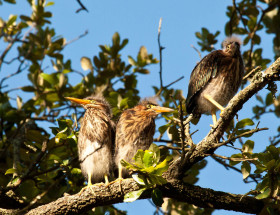
Brood of green herons just out of the nest in an urban colony in Norfolk. Green herons continue to be the most difficult species to achieve a reasonable population estimate. The species nests broadly in small groups or as single pairs. Photo by Bryan Watts.
Sea-level rise is a clear factor contributing to declines of several species. This is highlighted in the laughing gull population that has declined more than 46% in just ten years. Most of the wader species that have experienced deep declines have lost nesting habitat on bay islands that are rapidly eroding away. These islands represent significant and unique nesting areas for these species and are in jeopardy of being washed away completely over the next two decades.
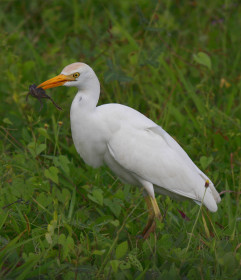
Cattle egret foraging in a field. Cattle egrets have been the biggest losers over the past 20 years with a population decline of more than 96%. This decline reflects a much larger geographic contraction in breeding range. Photo By Bart Paxton.
Colonial waterbirds are top consumers within aquatic ecosystems and are considered by many to be some of the most effective sentinels for aquatic health. As a group, the community has declined by 36% in Virginia since 1993 (94,947 pairs in 1993 to 60,901 pairs in 2013). We should continue to press toward a broader understanding of the underlying causes for this decline.
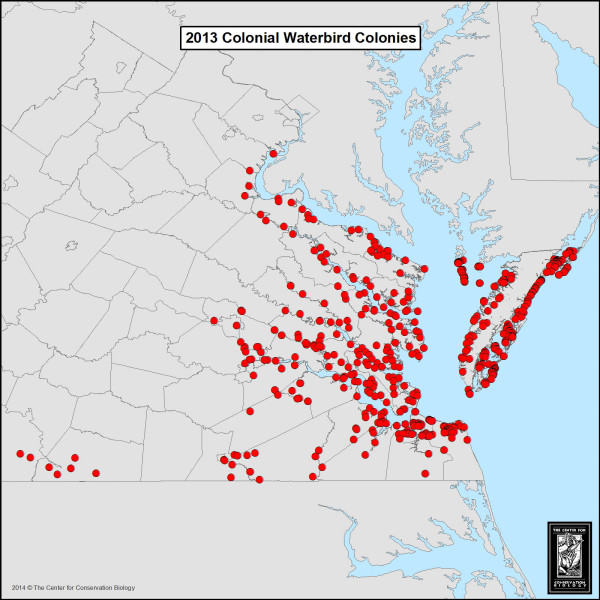
Map of 496 colonial waterbird colonies found and surveyed during the 2013 breeding season. Map by CCB.
The 2013 colonial waterbird survey was a collaborative, multi-agency effort lead by Bryan Watts and Bart Paxton of CCB and included the help of the Virginia Department of Game & Inland Fisheries, the United States Fish and Wildlife Service, The Nature Conservancy, the Virginia Department of Conservation and Recreation, the Virginia Department of Transportation, and the Army Corps of Engineers. We thank all of the many individuals who contributed time and expertise to the effort.
Table 1. Population estimates (breeding pairs) for colonial waterbirds nesting in Virginia (1993-2013). Data are compiled from systematic surveys conducted throughout the Coastal Plain by the Center for Conservation Biology and partners.
| Species | 1993 Pop. Est. | 2003 Pop. Est. | 2013 Pop. Est. |
|---|---|---|---|
| Waders | |||
| White Ibis | 3 | 77 | 369 |
| Glossy Ibis | 1008 | 818 | 484 |
| Great Blue Heron | 9112 | 9136 | 7809 |
| Great Egret | 2520 | 2720 | 2894 |
| Snowy Egret | 2329 | 882 | 1020 |
| Tricolored Heron | 767 | 507 | 718 |
| Little Blue Heron | 374 | 310 | 178 |
| Cattle Egret | 1459 | 166 | 56 |
| Green Heron | 154 | 60 | 49 |
| Black-crowned Night Heron | 526 | 640 | 358 |
| Yellow-crowned Night Heron | 388 | 241 | 299 |
| Gulls | |||
| Great Black-backed Gull | 514 | 1084 | 1172 |
| Herring Gull | 8801 | 4521 | 3326 |
| Laughing Gull | 45387 | 44953 | 24160 |
| Terns | |||
| Gull-billed Tern | 606 | 322 | 294 |
| Caspian Tern | 8 | 1 | 9 |
| Royal Tern | 6250 | 2858 | 5321 |
| Sandwhich Tern | 30 | 7 | 28 |
| Forster’s Tern | 2939 | 2477 | 2431 |
| Common Tern | 6781 | 1891 | 1985 |
| Least Tern | 1171 | 843 | 925 |
| Others | |||
| Black Skimmer | 3098 | 1828 | 1506 |
| Double-crested Cormorant | 354 | 1338 | 2876 |
| Brown Pelican | 368 | 1661 | 2454 |
| Total | 94947 | 79341 | 60721 |
March 31, 2014 by Bryan Watts | bdwatt@wm.edu | (757) 221-2247



